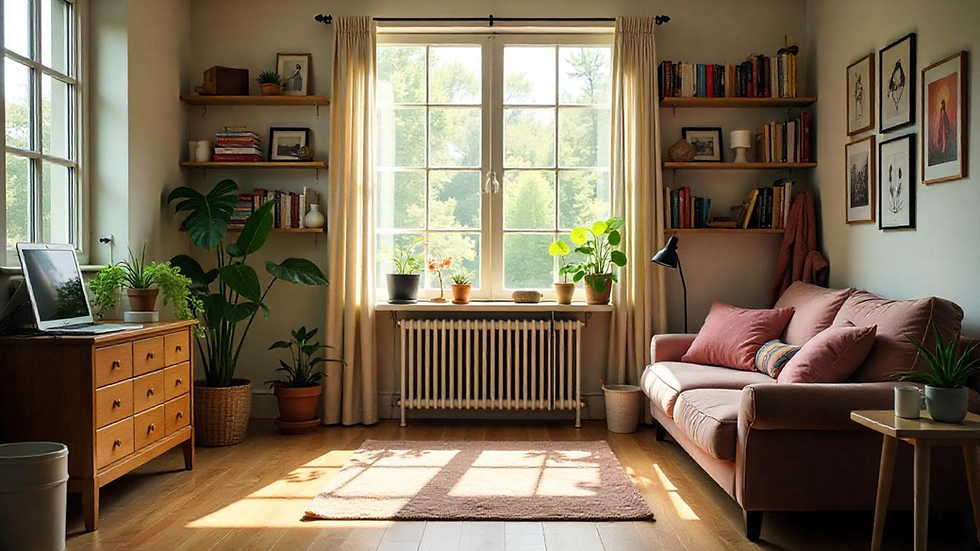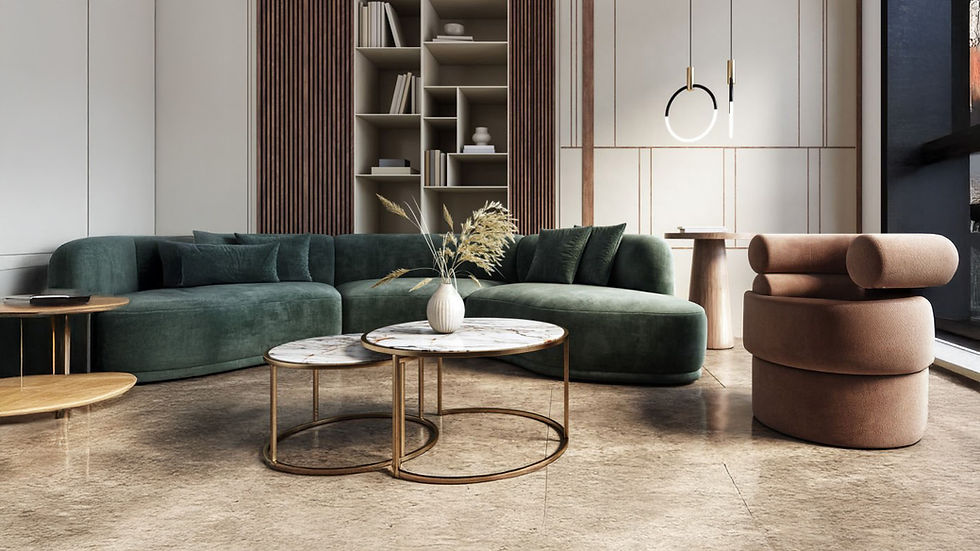Why Pinterest Inspired Spaces Don't Always Work
- Urbane Team

- Aug 13
- 6 min read

Pinterest has become a go-to destination for home design inspiration, offering an endless array of images showcasing stylish spaces that spark creativity and fuel daydreams. However, while Pinterest is a fantastic source of ideas, those picture-perfect interiors don't always translate seamlessly into real life. In this article, we'll explore why Pinterest inspired spaces don't always work in real-life scenarios, so without any further ado, let's get started.
The Conflict Between Pinterest-Inspired Spaces and Practical Design

Pinterest is an integral part of our digital lives, serving as a virtual mood board where we discover, collect, and share ideas. From home decor and DIY projects to fashion and beauty, there's something for everyone to pin. Yet while it shines at showcasing beautifully curated, idealized snapshots, real life often tells a different story.
Real homes aren't always perfectly lit or immaculately styled. They're practical, lived-in spaces that evolve with our needs, budgets, and lifestyles. This creates a clear gap between the polished perfection we see online and the messier, more dynamic spaces we live in.
Many of the designs we pin are aspirational and often overlook key real-world factors like:
Functionality: Will the layout or furniture truly support your daily routine?
Storage: That minimal look may not hide the mess life brings.
Space constraints: Most homes don't have sprawling rooms or soaring ceilings.
Budget: Designer finishes and curated pieces often come with a steep price tag.
Lifestyle needs: Pets, kids, and shared spaces all impact how a design needs to function.
Let's take a closer look at why these realities often clash with the picture-perfect vision.
When Aesthetics Overshadows Function

Many Pinterest-inspired rooms are styled with photography in mind. Open shelving, minimal furniture, or trendy decor may look visually stunning, but they miss the mark when it comes to practical design. Beautiful images can sometimes lead us to prioritize aesthetics over utility.
The challenge with many of these designs is that they often fail to address basic needs, such as storage, seating arrangements, or lighting. That beautiful open kitchen with no upper cabinets might look airy and modern, but will it offer enough storage? Will the plush white sofa survive in a house with pets or young kids?
A successful space strikes a balance between style and usability. Before replicating a look, ask how it will support your lifestyle. A home should feel good and function well, not just look good in pictures.
Also Read: How Smart Workspace Design Boosts Productivity.
The Reality of Space Constraints
One common trap is forgetting to adapt inspiration to your actual space. Many popular images show expansive, light-filled rooms with soaring ceilings and wide-open layouts. When you’re trying to copy a design without accounting for your room's size and shape, it can backfire.
What looks stunning in a spacious 1,500 sq. ft. open-plan living area might overwhelm a smaller apartment or a narrow room. Oversized furniture, blocked pathways, or awkward empty corners can leave a space feeling cramped instead of cozy.
Before jumping into a redesign inspired by something you've pinned, take a step back. Measure your space. Understand its layout, flow, and natural light. Then, ask yourself, can this concept realistically work here? Or does it need to be adapted?
You might need to scale down furniture, modify the layout, or rethink how certain elements are used.
The goal isn't to copy; it's to translate inspiration into something that fits your home's unique footprint. By designing with intention and awareness, you'll avoid the trap of form over function and create a space that's both beautiful and livable.
The Hidden Costs Behind the Look

Your picture-perfect dream spaces from Pinterest may look effortless, but what those images don't reveal is the budget behind them. Those curated aesthetics feature designer pieces, imported finishes, and custom details that can easily burn a hole in your pocket. They don't ask whether you're ready to invest in that marble countertop or handcrafted wood paneling.
When you're serious about renovating your home, every element matters. And nothing is more important than striking the right balance between aspiration and affordability. Materiality is just one part of the puzzle; aligning those choices with your budget is where real design begins.
Instead of chasing exact replicas of luxury items, consider smarter alternatives that offer the same visual impact. Maybe it's a locally sourced stone instead of imported marble or a beautifully crafted sofa in a durable fabric rather than a top-tier designer piece. Mixing high and low elements can still result in a cohesive, elevated look without overspending.
The Overwhelm of Endless Choices

Sometimes, Pinterest can be more paralyzing than inspiring. The sheer volume of options can leave you second-guessing every choice. Additionally, the more you browse, the more uncertain you feel, resulting in indecision, confusion, and a stalled design process.
This "Pinterest paralysis" can stall your design journey. Instead of moving forward, you feel stuck, unsure how to narrow things down or where to begin. The key to moving forward is focus. Start by identifying a few styles or color palettes that genuinely speak to you. Define clear goals for your space so your design feels intentional rather than pieced together from a hundred different sources.
While it's tempting to linger in the inspiration phase, interior design is ultimately about action. Ensure that you set timelines, make decisions, and begin transforming your ideas into reality one step at a time.
Why Professional Help Can Make a Difference

What often sets real homes apart from pinned images is the expertise that professional interior designers bring to the table. Interior designers don't just create pretty spaces. They consider lighting, scale, ergonomics, flow, and functionality in a way that online images often fail to capture.
When you hire an interior designer, they help you interpret your aesthetic preference through the lens of your space, needs, and budget. They spot issues before they become costly mistakes and ensure the final result is cohesive, practical, and tailored to you.
Furthermore, they also help you avoid common mistakes such as overcrowding rooms with excessive furniture or selecting color schemes that clash rather than complement. If you're unsure how to bring your vision to life or feel overwhelmed by all the options, a designer's input can bring clarity and direction.
How to Use Pinterest the Right Way

So, if you've made it this far, you already know that beautiful images are just the beginning, and there’s a reason why Pinterest-inspired spaces don't always work. However, there’s no need for you to feel demotivated, as here are some of the tips on how you can translate your Pinterest inspiration into something that truly fits your space and your life:
Identify visual patterns: Scroll through your saved images and spot recurring themes. It could be a color palette, a texture, or a certain shape of furniture. These details help clarify your style and provide direction for your design.
Adapt ideas to your space: Use inspiration as a guide, not a blueprint. What works in a spacious villa might need downsizing to suit a compact apartment or a narrower layout.
Work with what you have: You don't need a clean slate. A little reupholstery, a fresh layout, or a new accent color can refresh your space without requiring a complete overhaul.
Prioritize your lifestyle: Think about how you live, move, and unwind. Your space should reflect your daily rhythm, not just a fleeting trend.
Keep your vision focused: With so many options, it's easy to drift. Anchor your design choices around how you want your home to feel, whether that's calm, creative, warm, or minimalist.
Be flexible: Don't aim to recreate an image down to the last detail. Borrow the mood or elements you love and shape them to fit your setting, budget, and needs.
Always remember, the best design doesn't come from replication; it comes from intention.
Make the Pin Yours
Pinterest will always be a fantastic source of inspiration, but it works best when paired with a practical mindset. Let your pins spark ideas, then adapt, adjust, and shape them to fit your reality. That's where the magic of great design truly begins.
I hope this guide has helped you understand why Pinterest-inspired spaces don't always work. What’s your take on this? Let me know in the comments.



Comments